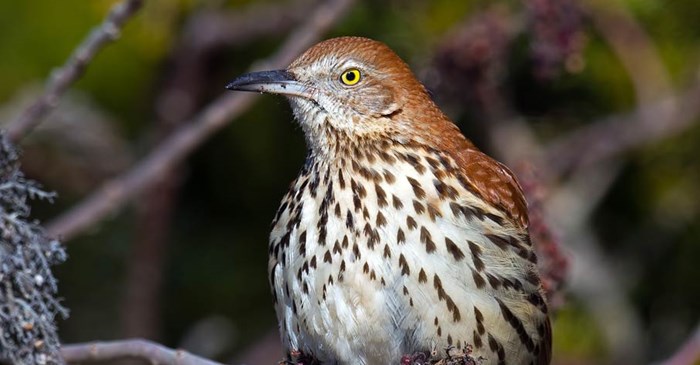If you’re an artist or crafter, the Brown Thrasher’s striking outline offers a pleasing bird shape, with its long legs, curved bill, and upward tilting tail. If you’re an audiophile, you'll appreciate this bird's wandering melody that some birders say is even lovelier than that of its more famous relative, the Northern Mockingbird.
Brown Thrashers can be found in shrubby areas throughout the eastern half of the continental U.S. Because they’re so easily camouflaged by their muted shadings of milk-chocolate brown, spotting them in their habitat can be tricky. To help you experience and appreciate these delightful birds, here are some things to know:
Locating the Brown Thrasher
While Brown Thrashers can be difficult to find, they are famously skilled mimics and songsters, boasting a “playlist” of more than 1,100 song types. The key to finding these birds by sound is keeping an ear out for a long series of doubled phrases. Then, if you get a glimpse of a brown bird with a spotted breast and startling bright-yellow eyes on the ground or in low branches, you’ll know you’ve found a Brown Thrasher. (As a memory aid, some describe the song of the Brown Thrasher as, “Plant a seed, plant a seed, bury it, bury it, cover it up, cover it up, let it grow, let it grow, pull it up, pull it up, eat it, eat it.”)
Nesting habits of Brown Thrashers
In a way, Brown Thrashers are more visible during the nesting season. That’s because they’re not at all shy about swooping in to attack invaders, including dogs and humans out for a stroll! Brown Thrashers nest in the dense vegetation of shrubby areas and low tree branches, which is also where predators like to hide. The threat of predators is the likely reason that the babies fledge at the tender age of 9 days old. Another challenge to the nest comes from the Brown-headed Cowbird, a songbird species that’s infamous for laying its eggs in other birds’ nests instead of raising its own young. The Brown Thrasher, however, is one species that recognizes the impostor egg and disposes of it before the much larger chick hatches and steals resources from the other babies.
Brown Thrashers in your backyard
Brown Thrashers spend much of their time on the ground, foraging for insects, berries, and seeds. When the Brown Thrasher visits your feeding station, it's more likely to peck around the ground for spilled seeds. When filling your feeders with Lyric Supreme Mix, scatter a handful on the ground as an offering to the Brown Thrasher. The black sunflower seeds, peanuts, and cracked corn will be a welcoming snack.
